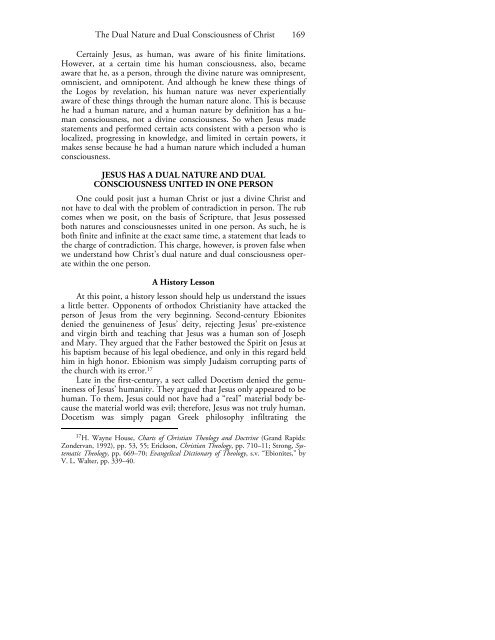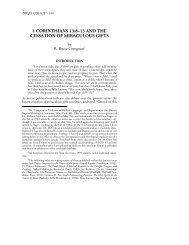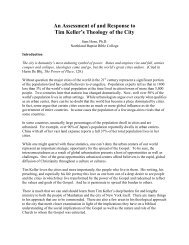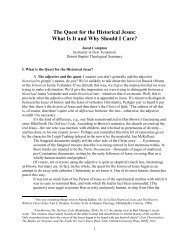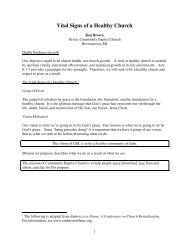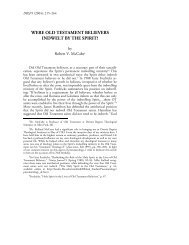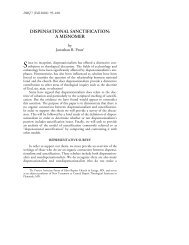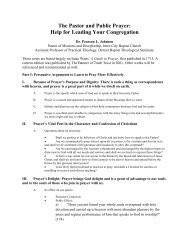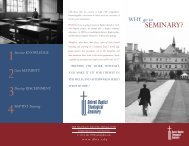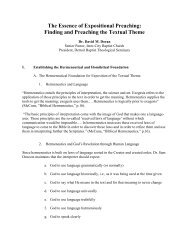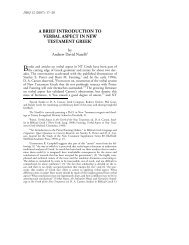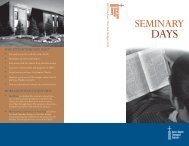Samuel A. Dawson - Detroit Baptist Theological Seminary
Samuel A. Dawson - Detroit Baptist Theological Seminary
Samuel A. Dawson - Detroit Baptist Theological Seminary
- No tags were found...
Create successful ePaper yourself
Turn your PDF publications into a flip-book with our unique Google optimized e-Paper software.
The Dual Nature and Dual Consciousness of Christ 169Certainly Jesus, as human, was aware of his finite limitations.However, at a certain time his human consciousness, also, becameaware that he, as a person, through the divine nature was omnipresent,omniscient, and omnipotent. And although he knew these things ofthe Logos by revelation, his human nature was never experientiallyaware of these things through the human nature alone. This is becausehe had a human nature, and a human nature by definition has a humanconsciousness, not a divine consciousness. So when Jesus madestatements and performed certain acts consistent with a person who islocalized, progressing in knowledge, and limited in certain powers, itmakes sense because he had a human nature which included a humanconsciousness.JESUS HAS A DUAL NATURE AND DUALCONSCIOUSNESS UNITED IN ONE PERSONOne could posit just a human Christ or just a divine Christ andnot have to deal with the problem of contradiction in person. The rubcomes when we posit, on the basis of Scripture, that Jesus possessedboth natures and consciousnesses united in one person. As such, he isboth finite and infinite at the exact same time, a statement that leads tothe charge of contradiction. This charge, however, is proven false whenwe understand how Christ’s dual nature and dual consciousness operatewithin the one person.A History LessonAt this point, a history lesson should help us understand the issuesa little better. Opponents of orthodox Christianity have attacked theperson of Jesus from the very beginning. Second-century Ebionitesdenied the genuineness of Jesus’ deity, rejecting Jesus’ pre-existenceand virgin birth and teaching that Jesus was a human son of Josephand Mary. They argued that the Father bestowed the Spirit on Jesus athis baptism because of his legal obedience, and only in this regard heldhim in high honor. Ebionism was simply Judaism corrupting parts ofthe church with its error. 17Late in the first-century, a sect called Docetism denied the genuinenessof Jesus’ humanity. They argued that Jesus only appeared to behuman. To them, Jesus could not have had a “real” material body becausethe material world was evil; therefore, Jesus was not truly human.Docetism was simply pagan Greek philosophy infiltrating the17 H. Wayne House, Charts of Christian Theology and Doctrine (Grand Rapids:Zondervan, 1992), pp. 53, 55; Erickson, Christian Theology, pp. 710–11; Strong, SystematicTheology, pp. 669–70; Evangelical Dictionary of Theology, s.v. “Ebionites,” byV. L. Walter, pp. 339–40.


